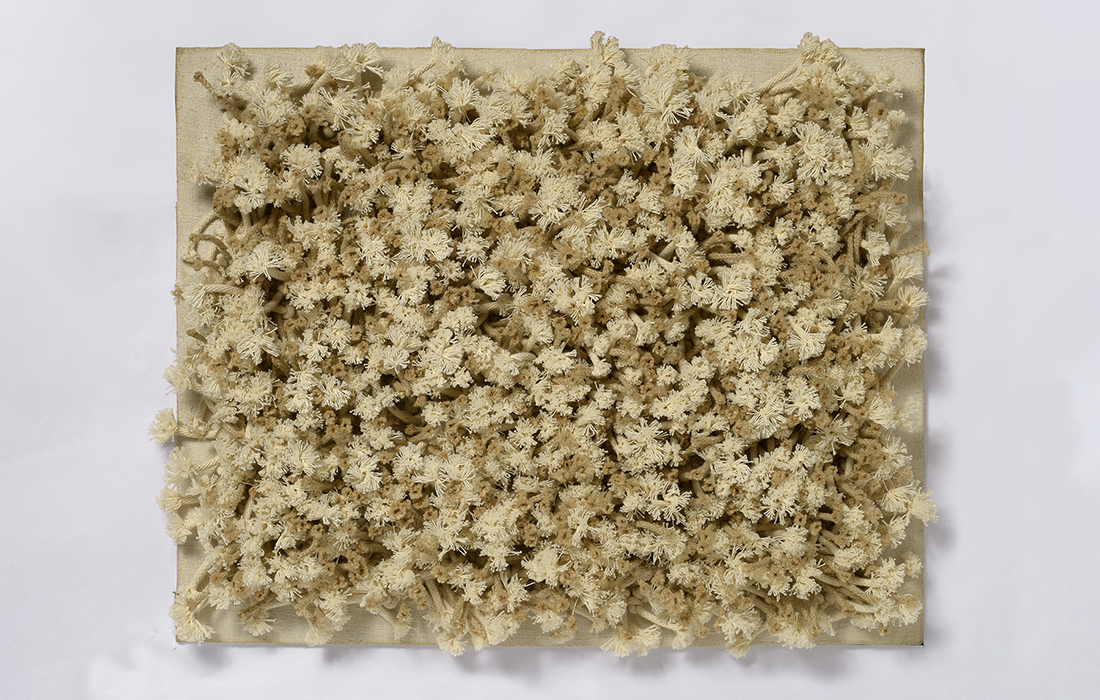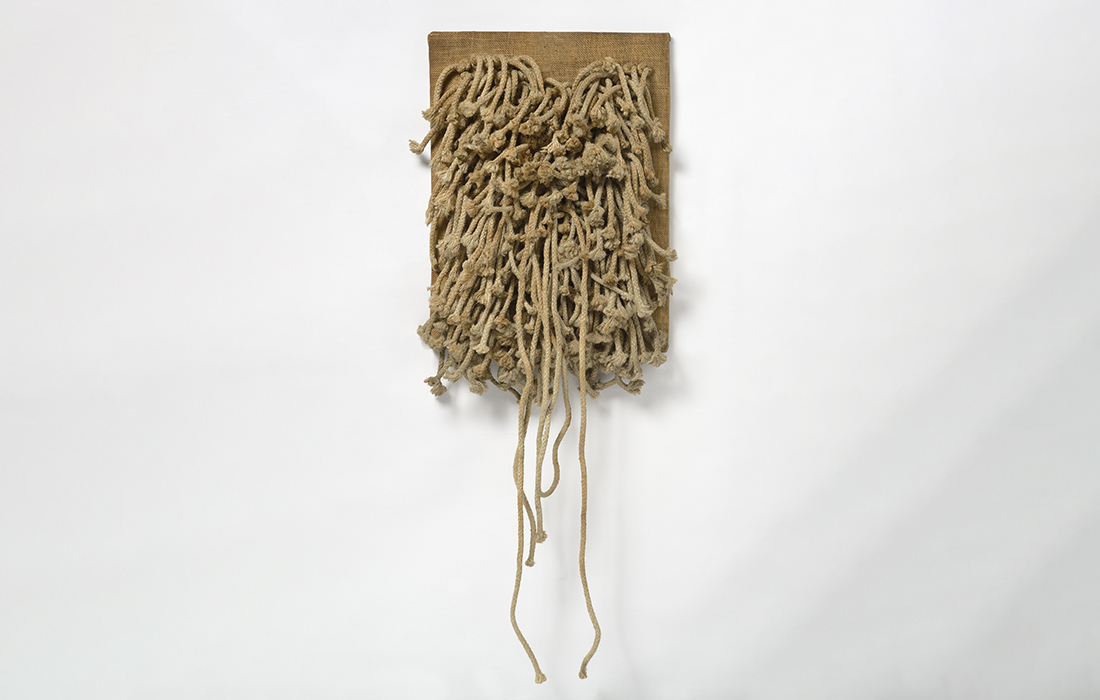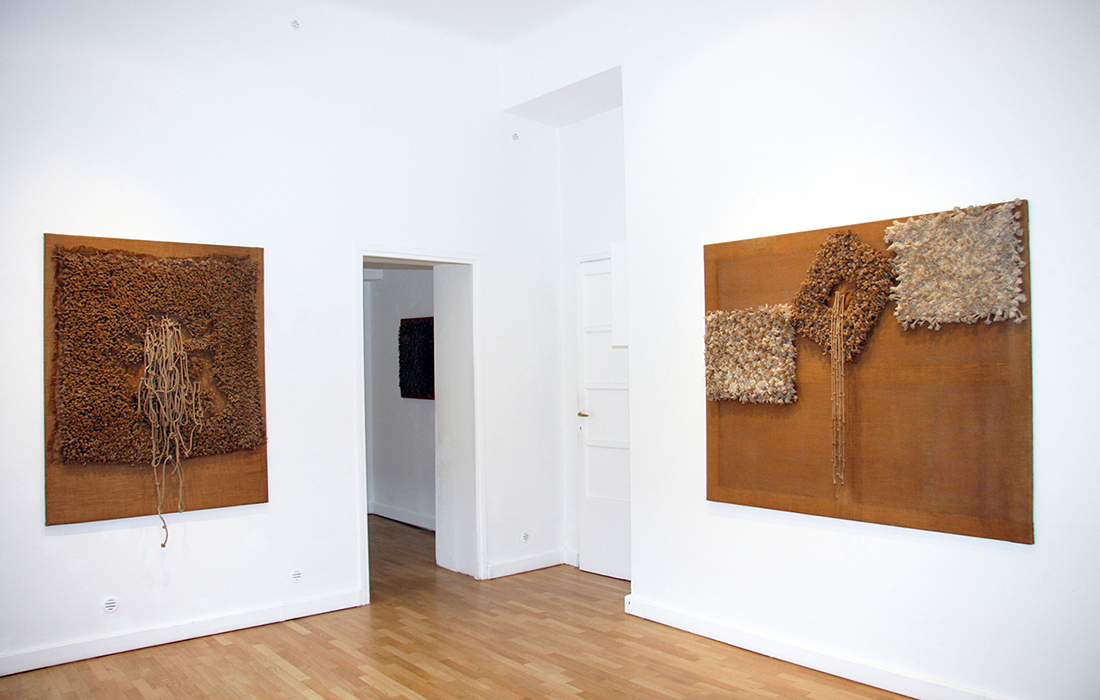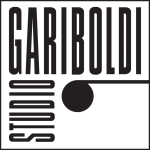April – June 2013
by Giuliano Zincone, Corriere d’Informazione, 1968
The latest paintings of Clemente are spiky exploded geometric figures, fantastic efflorescence, manes of underground animals, English meadows made of rope. Like all sorcerers, Clemente has something diabolical about him, playing at causing dismay and surprise: he ferociously believes in his unkempt evocations of the beyond.
The viewer will see eruptions of hemp bursting from the canvas, surfaces crossed by hard-to-define shuddering; approaching the painting, he is disconcerted, discovering that those menacing objects have been fabricated with the aid of apparently harmless pieces of twine. Yet this is precisely the ability of the alchemist: to stretch, through control, the unsuspected qualities (and therefore not harmless) of the most common materials.
Naturally this formulation applies both to colors and to objects: Clemente, who admires Kandinsky, is well aware of this. This very up-to-date artist who experienced the “roaring Fifties” in Paris, this refined painter, almost disdainful of all that is tired, worn and commonplace, chooses in his later career to use a rather outdated everyday material: twine, which by now is not even used to tie up packages.
The choice is obviously polemical, and while on the one hand it is in line with the Pop recycling of everyday things, on the other it constitutes an attempt to go beyond (or a rebuttal, at the level of language). Clemente feels close to Bonalumi and his plastic objects, he likes Fontana and, among his official masters, Kandinsky and Miró, but he is original precisely for his disturbing faith in geometry, the rigorous product organized through it (and here lies the paradox), the rigor and organization of the work. “If I could – he says – I would even make the frames of the paintings I display.” But this love of crafts, of things “well made,” should not lead us astray: the results strive for opposing emotions, arrows, triangles, comets, hallucinations of string (marijuana, too, is made of hemp), disheveled to the point of threatening any golden rule of reason.
Clemente sleeps in the carved bed of a bygone Jesuit General, warmed by a monumental Liberty stove. His hobby is visiting second-hand shops: proof of a love for beautiful, antique things, reinterpreted by a restless, almost frenetic imagination.
It is no coincidence that Clemente loves Michaux, the poet and painter of the indefinable. It is no chance that he absorbed, in France, with the Cartesian spirit, the clairvoyance of Artaud.
His sign, which alludes to uncontrolled eruptions, is never random, but the result of the diabolical skill of the craftsman, exact, organized, linear. At this point, for the incredulous viewer faced with the hemp flowers of the exhibition at the “Naviglio” (monochromes and dichromes that exorcise color, prior to reality itself), a bit of archaeological effort is needed: to reconstruct the prehistory of Clemente, from the gestural works of 1957 (“Pollock? Yes, but more materic”) to the Tondi of 1959-60 (multicolored works that remain a reference point for many young painters today), from the Misure (Measures) of 1963 (series of nebulous, apparently disorganized images: the moment of tangency with the extra-rational freedom of Schifano) to the exact divisions of violently colored surfaces of the production immediately preceding today’s exhibition.
But this chronology, though evidently sustained by a continuous evolution of language and of coherent, precise display, would not define Clemente, who hates any systematic, devitalizing form of cataloguing. We prefer to point, instead, to the eclecticism of this painter, his presence as a complete artist, sensitive to the jolts of the most advanced contemporary culture: an exuberance that has permitted him to take part in experiences of the Parisian theater avant-garde as a choreographer, musician and set designer (in the American tradition of Oldenburg, Rauschenberg and above all Kaprow, inventor of the “happenings”), and has involved him in some of the most interesting experiences of color television in France.
Archaeologies of a recent past
by Francesco Tedeschi
“For the artist who accepts our time, form ceases to be an immobile remainder with a single meaning, revealing itself as the symptom of a multi-purpose Becoming. Form becomes ‘formation’ and the painter the chronicler of its emerging, explorer of its latent latitude of meanings…” (words of Jack Clemente published in P. Rouve, “Clemente by Pierre Rouve,” in “Art News and Review” Vol. XII No. 4, Saturday, March 12, 1960, p. 5) These are the thoughts of Jack Clemente, the original and practically forgotten figure of the versatile and, in a certain sense, stateless artist. In them we can grasp the sense of restlessness, the thrust of invention and experimentation, the correspondence between doing and becoming, that constitute the reasons behind an incessant will to innovate.
This is what drove him in the short, intense span of his career: one of the most lively and fertile periods of recent history, in which the transformations of operative modes and the reasons behind artistic endeavor have produced many different, multiple solutions.
The sizeable nucleus of works rediscovered and presented in this exhibition constitutes an interesting episode in this epoch, a part of the artist’s output that has thus been rescued from oblivion, and recovered with an operation that can be defined as “archaeological.” Clemente drew on archaeology for inspiration, interests for the creation of works that in various ways establish a dialogue with the past, with myth and the origin of time. A primordial sense of the aurora hovers in his “informal” compositions of the second half of the 1950s, when in Paris he experimented with pictorial techniques that are related to Tachisme, to the “materiologies” derived from the proposals launched in the mid-1940s, but somehow already go beyond painting as such. The sign and the material, spread in a space without connotations, are traces of a timeless time, evoking arcane places, with some inheritance from that Surrealism that runs through much of (not only) French visual and expressive culture. Of this period of Clemente, which nevertheless led to singular achievements, little, even very little is known today, and we are left to hope that one day it will be fully recovered, perhaps along fortuitous paths, and taken back into account. What can be observed with renewed attention today is in any case a sizeable nucleus of his later output, begun after the mid-1960s, in a different atmosphere. These works made with a technique endowed with metaphorical qualities in itself are “rediscovered” today, in all senses of the term. The “cords” and “knots” with which Clemente composes his “paintings” starting in approximately 1966 are, in fact, instruments and objects that apparently situate themselves beyond and outside of painting, yet conserve the memory and perhaps the necessity of the painting. They are the works Clemente presents in his third exhibition at Galleria del Naviglio, in January 1968, where he asks that a page of typewritten letters in sequence be published, instead of a critical text. The exhibition and those previous, in 1962 and 1966, together with the show at Galleria del Cavallino in Venice in July 1963, constitute an important sequence of events, joined by participation in a number of group shows in the two galleries of the Cardazzo family (the first, in 1962, is the result of direct contact with Carlo Cardazzo, who passed away the following year. In the course of the 1960s Clemente gained a rightful place among the protagonists of Italian art, establishing relationships on the Milanese scene, where he had already shown work in the mid-1950s. He was now urged on by relationships with Dova, Fontana and other artists in the Milanese context that emerged from the dialectical combination of Spatialism and Nuclear Art, currents reflected in his early output in clear but original affinities. In the late 1950s his work was particularly sought out by a singular collector and patron, Charles Damiano, a Pirelli executive residing in London and a major supporter of avant-garde research, who helped to spread awareness in England and on an international level of the work of Clemente, Lucio Fontana, Roberto Crippa and Gianni Dova, also facilitating the inclusion of their works in the collections of the Tate Gallery. In close contact with each of the artists, he attempted to connect them with collectors, gallery owners, dealers and museums on an international scale. From the ties between Damiano and Clemente, documented in copious correspondence, we can also see that at the start of the 1960s certain problems of conservation, caused by the composite techniques with which Clemente made his paintings, created difficulties and perhaps some misunderstandings between them. Clemente, also the author of an important text presenting the photographs of Damiano himself, featured in several exhibitions in England in those years, was probably going through a phase of critical reflection, leading to further experimentation in the course of the early 1960s, as borne out by other works in which at least the shadow of the image resurfaces. His first solo show at the Naviglio, following those held in London and at other galleries, still included painted works with an Informal matrix, which would be abandoned later in pursuit of other directions that lead to the works of the second half of the 1960s. With respect to this introduction required to re-examine the work of an artist that has never had an exhibition in Italy after his death in 1974, the roughly unitary whole of the works presented on this occasion represents an important opportunity. The works seem to be organized around different phases of development, recognizable in shifts that seem minor, at first glance, but essential, and can be investigated in terms of their specific quality, as part of a moment of decisive transformation for the art of those years. An aspiration to get beyond the pictorial quality, in the stricter sense, is inherent to many forms of the art that takes part in the evolutions of the Informal. To remain on an Italian horizon, among positions that in some way might have to do – seen a posteriori – with the choices made also in an intuitive way by Clemente when he turns to cord as a compositional material, we can consider on the one hand the “sacks” of Burri, and on the other the “wrinkled” canvases of Manzoni, two models that demonstrate, with the intention of transforming the background material into “raw material,” the need or the possibility of an escape from painting, based on the very substance of the painting itself. We can see the string, in fact, as a surrogate of the material that constitutes the surface of so much painting, that canvas that has encountered different kinds of reinterpretations throughout the 20th century, becoming an expressive motif in its own right. The bare canvas of the works left intentionally in an unfinished stage by Cézanne could even be indicated as the prelude of a focus on the materic quality of the surface itself, which will later be combined with other experiences of analysis of the process of painting, reaching the autonomously materic and completely formal value of the works of Burri after World War II, but also the later explorations of the component of protrusion of the canvas, as happens in Scarpitta, Castellani and others still.
This focus on the value of the surface material, enlarged in its weave, expanded and made into the component of structures that pass through a “zero degree” of painting, is one of the characteristic aspects of the new form of painting invented by Jack Clemente. Not by chance, at first it is structured as a homogeneous and continuous volume, marked by the pursuit of a formal inexpressivity, which may be a sign of the necessary focus on the characteristics of the new material and the new technique. Clearly the first paintings with the strings tangled in knots that display a possible continuity of the gesture that goes into the composition of the new surface, or which when “trimmed” become a sort of seamless field of efflorescence, reveal similarities to that sense of neutrality investigated by the “achromes” of Manzoni, in the form of the “cotton batting works” that encourage, like the “cords” of the first Rituali (Rituals) by Clemente, a tactile approach, if only for the eyes, rather than examination of a visual and formal nature. Beside and inside the choice of an unusual material, though one that is in the history of painting itself, with reference to the weave of the canvas and an action that generates the composition through a new “sewing” for which the verification of the union between technique and result also becomes interesting, on the back of the work we can also undoubtedly see the passage belonging to so many achievements of the 1960s, from the pictorial-representative value to the eminently objectual value, acting upon the various thrusts of a neo-Dadaism that in France had grown up around the positions of Nouveau Réalisme and the critical thinking of Pierre Restany. Other pressures towards recovery of the physical dimension of the painting-as-object could be found in the context of Spatialism itself, and Roberto Crippa with his “corks” can constitute an emblematic turning point, though integrated in his individual experience. The urge to achieve an objectual status of the pictorial material itself encourages, at the end of the 1950s, ulterior reasons for intolerance of the Informal period, revealed in the reactions to the manner of the pictorial pastiche triggered by pictoricism itself, almost by a resurgence of naturalism. An artist like Bonalumi, a friend of Clemente, also explores materic combinations between painting and naturalistic materials, in his productions that reject the specifically pictorial matrix to recover its “objectual” quality. Clemente’s objectuality progressively takes into account the combination of things and forms that from neo-Realist assertions (the Arman of the flattened paint tubes and various kinds of materials) arrives towards the most distilled arrangement of images and things in a Pop key, but remains inside the will to make the painting a painting, i.e. a veiledly pictorial structure of the obtained protruding surface. Halfway through the decade, in Milanese circles, the trend towards “objectual painting” is identified as a characteristic, which could cover the works of a core group of artists like Castellani, Scheggi, Dadamaino, Alviani, Bonalumi, Simeti, bent on interpreting in a particular, differentiated way the combination of monochromy and form taken on by the canvas treated in various ways, in a direction that has to do with the “spatial” transformation of the concept of the painting, as well as with new formulations of an elementary technology of the aesthetic project, but which above all survives inside thinking about the reasons and the function of the painting. The “object” derived from the wedding of technique and material, in Clemente, is always based on its essence as a painting, even when its original developments seem to negate its presence or consistency. As happens in the work Untitled, from 1968, where the surface of the “carpet” of cords opens a circle on the wall below, again finding extension in the upper zone, almost as if to complete the inner pressure of the surface, which thrusts the void produced inside it towards the outside, similarly to what happens in certain works based on the variation of the structure of the support of the artists mentioned above.
Instead, it does not seem pertinent to make comparisons with the models proposed in the area of the constellation of Arte Povera, as it was taking form, precisely due to Clemente’s insistence in the direction of the work-painting, which though at times implemented with ironic accents, never strays into the nude presentation of active materials, as happens in Boetti or, later, in Calzolari or Zorio. Some affinities can be glimpsed with the tactile modulation of the surface of certain objects made by Pascali, but with clear representative more than spectacular value, and in fact when Clemente returns to “narration” and construction of forms, also through the introduction of ulterior combinatory elements, he does so by offering an iconic dimension to the materic bodies. The use of regular segments of wood, in the form of rectangular boards or round pieces, crossed by the cords that tie them on the surface, leads to an identification of “heads” or of new variable formations, in the series of the Proliferazioni (Proliferations); a name Clemente assigns to the works done in a second moment, or also parallel to the first formulation of this nucleus of works, to underline the value of superfetation with respect to the painting, externalizations of a compositional principle that makes the painting become variable by means of the physical and visual movement to which it is subjected. Something archaic is also evident in this phase, leading back to his work in tune with a primitivism he himself appreciated, seeking out extra-European sculptures of particular expressive impact. In a certain sense, applying the simple manipulation that comes from combining everyday craftsmanship with the originality of the single piece, Clemente grants life to a new qualification of the object based on its sensual and magical virtues, which from the tactile quality of its skin are transmitted to the new formal solutions. In terms of “New Fetishisms” his pieces become personages, figures, totems, in the simple structuring the small wooden segments, used as an ulterior sign-construction motif, are able to generate. Like complex ideograms, the protagonists of his pieces evoke stylized subjects, where the human presence is evoked by absence, to the point of appearing phantom-like in what is perhaps the most original work in this last, extreme series of creations by Clemente, that Archeologie del passato (Archaeologies of the Past) where a camouflage uniform appears, which might suggest reflections on war and pacifism, a topic that at the time found immediate impulses from Vietnam and the Israeli-Palestinian conflicts, summed up in the most widespread slogan of the day, “I Care,” expressing the need for political and emotional participation in the dramatic events of the time and the world. From the “past” what emerges, for Clemente, is a military uniform that is actually in the present, absorbed by his ropes and knots that make us think, in this specific case, of the trimmings and medals of the “Generals” of Enrico Baj, but with an intention that is more existential than ironic or polemical. If we have mentioned the names of many artists in these thoughts prompted by observation of the works of Jack Clemente that have emerged from the attics and storerooms where they were conserved, it is not to cast doubt on their originality or their importance, but to try to reinsert them in a context and a historical moment in which they were generated and of which they form a trace, in their own way. Like any “archaeological” find, the works of Jack Clemente are destined to contribute to the reinterpretation of a situation, but also of an expressive and compositional model, which could lead to further investigation. Starting precisely with their specific quality, the choice of a material so akin to the surface of painting can prompt further considerations regarding the use of “cords” in an objectual and compositional way, which from Miró, who in Corde et personnages I, 1935, places a twisted cord on the painting, in the phase of exploration of the materic-sculptural components that go beyond painting could lead to the authors mentioned above, active in the 1950s and 1960s, and then reach Claudio Cintoli, Angelo Savelli, all the way to individual works of Boetti, Merz, Kounellis. All this could constitute one of the many iconographic-metaphorical paths along which to reinterpret that recent past for which an anomalous, original and in his own way anarchical personality like Jack Clemente was an active investigator and interpreter.






